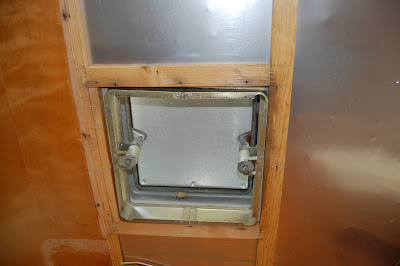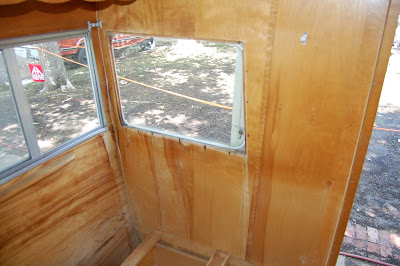Now it’s time for paint. I have read and reviewed a ton of arguments about letting professionals paint it versus do-it-yourself jobs and spraying versus the $50 roller method. I planned on doing this in the driveway one side at a time over a few weeks. I wanted something durable, that looked good to the average camper owner, and was easy to touch up if something scratched it. $1,000 to $2,000 on a pro job was out. Spraying in
“Where the wind comes sweepin’ down the plain”
 After reading about the $50 dollar job on a few Shasta sites and a couple automotive sites, I decided it would be easy enough. Besides, even at $150, if I decided I wasn’t happy after a few years, I could strip it and spray it. Here are a couple good places to get started researching:
After reading about the $50 dollar job on a few Shasta sites and a couple automotive sites, I decided it would be easy enough. Besides, even at $150, if I decided I wasn’t happy after a few years, I could strip it and spray it. Here are a couple good places to get started researching:
Paint Techniques and The $50 Paint Job
So I went to Lowe’s and got about $30 dollars worth of 6” foam rollers, small foam brushes, and some throw away paint trays. I also got a roll of Frog Tape for $10. I picked up a spray can of self-etching primer for the bare aluminum spots for about $5 and a can of Goo Gone for $3. I got my paint from Sherwin Williams. It is their Industrial Alkyd Enamel; they keep it in the back room, far away from
As I began prepping the trailer, I decided that Cheryl was right. That’s right folks, I am saying right here that she was right. It just made more sense to do what she suggested and move this project indoors. I figured that as soon as I pulled windows out on one side, a monsoon would arrive and I would be trying to cover wet paint with a tarp. So we packed up, went to the in-laws for the weekend and put the camper in the shop. Now there was still dust and dirt (it’s a farm shop) and there was no practical way to set up proper ventilation for spraying, so I stuck with the roller method.
I spent most of the day Saturday pulling windows, rusty screws, vent covers and door hardware. On the Hehr windows, the Jalousie windows are pretty straight forward, basically you remove the screws, and peel the window off the trailer. On the other Hehr windows, the ones with the hinge along the top, there are hidden screws under the old crusty rubber moulding.

Once ALL of the screws were removed, the window popped right out.
Some screws had to be persuaded. Once again, some were so rusted that they had to be backed out with vice grips.
Some of the more difficult ones I tried to drill out, but they were harder than hell.
This made me very unhappy.
So I resorted to grinding grooves in them with a cut off wheel and backing them out with a big flat blade screwdriver.
The old putty tape was dried out and just fell off onto the ground. I had a few places where it still hung on for dear life and I had to persuade it with a plastic putty knife. Once I had the windows out, I just stacked them in an out of the way corner for polishing later. I labeled the back windows, drip edges and access doors with a sharpie in case they were not interchangeable.
I removed the lights taking pictures as I went so I would have a reference for wiring. I will address this more when I talk about reinstallation in a later blog. I will talk about the removal and rotted condition of the wings at a later time as well.
With the windows out, I was ready for paint prep. I had to wire brush the remains of the old putty, silicone, and other various other kinds of caulking from various periods of its life.
After most of the gunk was ground off, I went back with Goo Gone to clean off the last of the goo.
I used the Frog Tape on the stripe to get the cleanest line possible.
I then went over the entire camper one last time with a mild solution of TSP substitute and water.
I then used the etching primer on the bare aluminum areas around the stripe and other bare spots on the trailer.
After letting it dry overnight, I was ready to start rolling. I started on the upper half with the white, working quickly from the upper corner, keeping the edge wet and watching for drips. I had a small foam roller and brush that I used along the edges as I went. I worked all the way around the trailer, rolling on a light coat, and then letting it cure for eight hours. I ended up using four coats to get the coverage I wanted. Three would have been okay, but I wanted another coat to help with scratch resistance.
First Coat:
Second Coat:
Third Coat:
Fourth Coat:
I then used some less expensive blue tape along the upper edge to protect myself from the occasional wild roller with blue paint.
The blue paint covered much better than the white and I ended up only using three coats.
First Coat:
Second Coat:
After the last coat of blue had cured for eight hours, I removed the tape one side at a time, pulling sharply at an angle away from the painted edge. The Frog Tape made beautiful edges.
I only had a couple spots that bled through and this was due to user error. All in all, I am completely satisfied with the results. It took me two weekends to finish, but I was polishing windows and goofing off while I watched the paint dry. I have a few touch-up areas, a couple drips to sand, and two spots where I still got too crazy with the roller, but I will do those after the paint has cured for a couple weeks.
So, if you are following along, so far we have:
Trailer $900
Bearing Repack $100
Steel $10
Sealant $10
Fan-Tastic Fan $140
Three Sheets 1/8 Birch $50
3M Polish $18
Buffer Pad $12
Mothers Aluminum Polish $8
TSP Cleaner/Paint Prep $8
Rollers, brushes and trays $30
Frog Tape $10
Etching Primer $5
Goo Gone $3
Paint 3 Gallons $98
Bringing our tally to: $1,422
Until next time dear readers, shasta la vista...























































